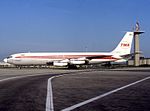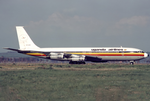1973 Rome airport attacks and hijacking
In December 1973, a Palestinian terrorist group executed a series of attacks originating at Rome-Fiumicino Airport in Italy which resulted in the deaths of 34 people. The attacks began with an airport-terminal invasion and hostage-taking, followed by the firebombing of a Pan Am aircraft and the hijacking of a Lufthansa flight. Pan Am flight 110 was scheduled to depart from Rome, Italy and arrive in Tehran, Iran, by way of Beirut, Lebanon. On 17 December 1973, shortly before takeoff, the airport terminal and the flight aircraft were attacked and the aircraft was set on fire by armed Palestinian gunmen, resulting in the deaths of thirty persons on the plane and two in the terminal.Following the flight 110 attack, the gunmen hijacked Lufthansa Flight 303 and killed two more people. They ended up in the custody of the Kuwaiti authorities.
Excerpt from the Wikipedia article 1973 Rome airport attacks and hijacking (License: CC BY-SA 3.0, Authors).1973 Rome airport attacks and hijacking
Via Leonardo da Vinci,
Geographical coordinates (GPS) Address Nearby Places Show on map
Geographical coordinates (GPS)
| Latitude | Longitude |
|---|---|
| N 41.800277777778 ° | E 12.238888888889 ° |
Address
Via Leonardo da Vinci
00054
Lazio, Italy
Open on Google Maps










